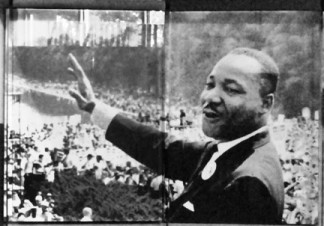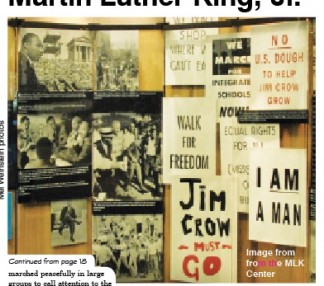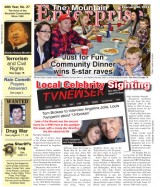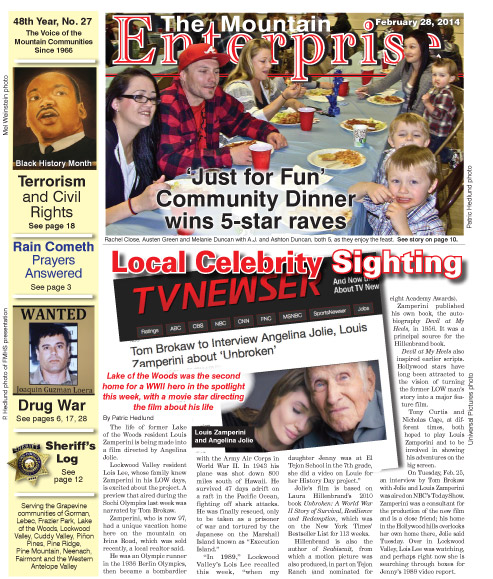
Image 1 of 2
Martin Luther King, Jr. gave his famous “I Have a Dream” speech at the Lincoln Memorial in Washington, D.C.
Image 2 of 2
The Civil Rights Movement began in the mid 1950s and swept through the South into the 1960s, a hundred years after the Civil War. It was an effort to at last provide the full rights of citizenship to all and to end Jim Crow laws that discriminated against African Americans and others.
By Mel Weintstin, Pine Mountain
On February 21 I was invited by Mrs. Anne Coyle at Gorman Elementary School to address her third and fourth grade class. I went to college to become a teacher and taught history for several years before taking up photography full time. But history has remained a passion.
February is Black History Month, so the topic Mrs. Coyle asked me to speak about was Dr. Martin Luther King, Jr. and his significance. I made an outline of points to cover in 20 minutes, but the students turned my talk into an hour and a half discussion on topics I hadn’t considered.
I started by asking questions: What is a hero? Who are your heroes? What national holidays do we celebrate during the year?
This led to a talk about President’s Day that honors President George Washington and President Abraham Lincoln. As a general, Washington led America’s struggle through the Revolutionary War. As president, he guided the young country in its first dangerous years.
President George Washington was a landholder in Virginia in the 1700s. Along with his land, he inherited slaves and did give them their freedom.
It was not until 1863 that President Abraham Lincoln freed slaves in America’s south. Lincoln kept the United States from breaking apart despite the Civil War.
The Gorman students talked about what it meant to be a slave. They discussed the differences between a revolutionary war and a civil war.
I talked with them about how discrimination grew after the end of America’s Civil War in 1865. The 15th Amendment was passed in 1866 to give freed slaves the right to vote, but terrorist groups such as the Ku Klux Klan and white militias used lynchings and other kinds of violence to frighten former slaves, to keep them from voting.
In 1876 southern states were able to pass “Jim Crow” laws to enforce segregation. Discrimination under these laws became ‘normal’ in most parts of the south. Even in Arizona and California it was legal to restrict who property could be sold to, based on race.
In the South, African Americans could not ride on buses and trains with white people. They had to go to schools that were inferior. Former slaves could not go to the same restaurants or stores as white people. They couldn’t even drink from the same water fountains.
Then, in the 1950s, brave people like Rosa Parks became revolutionaries in a new kind of war. Parks, 42 was arrested and convicted of violating the Jim Crow segregation laws for refusing to give up her seat on a bus to a white person.
The Civil Rights Movement was a war to win the civil rights guaranteed under the United States Constitution and the Bill of Rights for all Americans, not just some of them.
Dr. Martin Luther King, Jr. was a young Baptist minister who became a new kind of general in the war for civil rights. In 1955 he was recruited to serve as spokesman for the Montgomery Bus Boycott.
King said that the way to win a war against discrimination is through love and non-violence. He said that no matter how much someone hates you because of the color of your skin, you shouldn’t fight back with fists or with guns.
The African American community decided to boycott the buses in Montgomery. They decided to walk or carpool instead of riding the bus. They marched peacefully in large groups to call attention to the discrimination.
The movement included sit-ins at restaurants that refused to serve African Americans.
Last week, the Gorman students talked about how sit-ins and boycotts forced businesses to reconsider the economic consequences of discrimination.
During the Civil Rights Movement, news reporters showed the protest marches on television. When the police and white people in the South used violence against peaceful marchers, the whole world saw the cruelty of discrimination.
In 1963 Dr. King led a march on Washington, D.C. Hundreds of thousands of people, black and white, went there to protest discrimination. This is where Dr. King gave his most famous speech, “I Have a Dream.”
He spoke about people judging each other for the content of their character rather than the color of their skin.
Dr. King felt he would be assassinated someday, but it never stopped him from marching openly in the streets. He used words as powerful tools to make all people understand that discrimination and segregation in our country had to end. Since the laws of our country promoted segregation and discrimination, the laws needed to be changed.
In 1963 President John F. Kennedy called for a civil rights act to ban segregation. After Kennedy’s assassination in November 1963, President Lyndon Johnson used his power as president to help break a 57-day filibuster in the Senate and to get Congress to pass a Civil Rights Act, signed into law on July 2, 1964. Its goal was to put an end to Jim Crow laws that placed economic, educational and social disadvantages on African American people, including making it harder for them to vote in elections.
Many people were murdered during the Civil Rights Movement of the 1960s. Dr. King was one of them. He was killed in Memphis, Tennessee on April 4, 1968 where he was leading a strike on behalf of the garbage collectors there. They were mostly African Americans who made just 75 cents an hour, wages far lower than those earned by most white people who worked at labor jobs.
Martin Luther King, Jr. was murdered when he was only 39 years old. He had fought for justice for all people who suffered from discrimination. He inspired people to stand up for their right to be equal citizens under the law.
The Civil Rights Movement had ended the idea of “separate but equal.” It won all people the right to go to the same public schools, to live where we want, to eat where we want and to walk down the street without being afraid, no matter who we are.
I told the Gorman students that Dr. King is my hero because he stood up for what was right and made it possible for others to stand up with him. He knew his short life would make the lives of others better for a long time. He made the world a better place.
Since I hadn’t been in a classroom for 40 years, I am sure this experience meant more to me than it did to the students. I look forward to volunteering in the schools again soon.
Photo captions:
Martin Luther King, Jr. (far left, white shirt and hat) and his wife Coretta Scott King on the march from Selma to Montgomery, Alabama.
Image from from King Center, Atlanta, GA.
King was shot on the balcony in front of Room 306 of the Lorraine Motel in Memphis, TN. The building is now part of a Civil Rights Museum.
To see full stories with photos, please go to The Mountain Enterprise e-Edition
(login required)
You can have your newspaper delivered via mail! Just call 661-245-3794.
Also, this story and others are available right now at newsstands throughout the Mountain Communities.
This is part of the February 28, 2014 online edition of The Mountain Enterprise.
Have an opinion on this matter? We'd like to hear from you.


